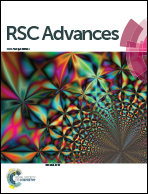First-principles study of vanadium carbides as electrocatalysts for hydrogen and oxygen evolution reactions†
Abstract
Vanadium carbides have attracted much attention as highly active catalysts in both the hydrogen evolution reaction (HER) and oxygen evolution reaction (OER), while a satisfactory understanding of the underlying mechanisms still remains a challenge. Herein we apply first-principles calculations to systematically analyze the crystal structures, electronic properties, free energies during the HER and OER processes, surface energies and crystal formation energies of the three types of vanadium carbides, i.e., V4C3, V8C7 and VC. We show that all these vanadium carbides are metallic, which enables efficient electron transport from the bulk to the surface of the catalysts. All these vanadium carbides exhibit excellent HER performance but show poor OER catalytic activity. In particular, the V8C7 (110) surface shows the best catalytic performance for its relatively small |ΔG(H*)| value (−0.114 eV) for HER. Emergence of natural carbon vacancies gives rise to large surface energy, proper hydrogen adsorption energy, low crystal formation energy and weak bond strength in V8V7, which guarantees its leading position among the three vanadium carbides. In addition, a remarkable resemblance between VC/V8C7 and Pt in their electronic structures on (110) and (111) surfaces are found, which indicates a Pt-like HER mechanism in these vanadium carbides. Our results thus bring new insights to the theoretical understanding of the excellent HER performance of vanadium carbides.



 Please wait while we load your content...
Please wait while we load your content...